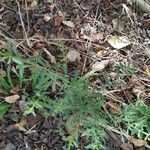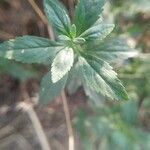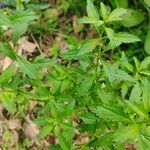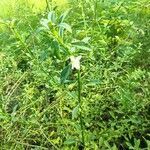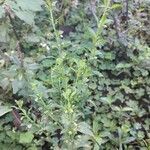A herb. It grows 1 m tall. The stems are square. The leaves are simple and have 3 in a ring. They are 1-4 cm long and up to 2 cm wide. They surfaces are like sandpaper. The flowers occur in a cluster of 1 or 2 flowers. The flowers are 6 mm across. There are 4 white or pink petals. The fruit is a brown capsule. It is 2-4 mm long and has 2-4 valves. The seeds are brown.
Leaves 1.2–4.5(5.5) x 0.2–0.9 cm., usually ternately whorled or occasionally opposite, narrowly oblanceolate to elliptic-lanceolate, narrowed towards base, apex acute or obtuse, crenate to clearly and sometimes deeply serrate in upper half, almost entire below, glabrous, densely punctate, nerves prominent below.
Flowers solitary or more rarely paired in axils of leaf-like bracts, forming branched, many-flowered raceme-like inflorescence; pedicels up to 0.7 cm. long, filiform, glabrous.
Woody perennial or subshrub to 60 cm. tall, erect, much-branched, glabrous or minutely hairy especially at nodes; stem and branches angular or ribbed.
Calyx 1.5–2.5 mm. long, 4-lobed, lobes ovate to oblong, obtuse, shortly ciliate towards apex.
Flowers white or bluish, usually 4 petals, densely bearded inside.
Corolla 2.5–3.5 mm. long, white to pale mauve.
Capsule 2–3.5 mm. long, ripening pale brown.
Erect shrubby weed 1-3 ft.
